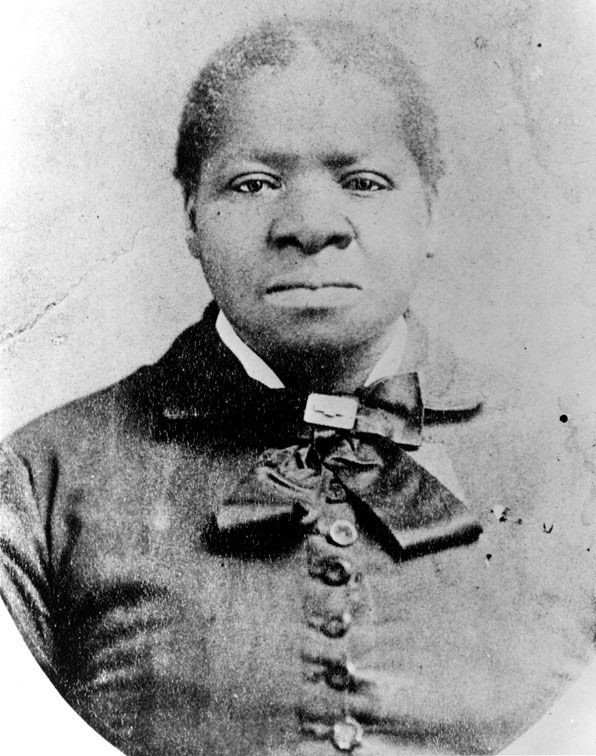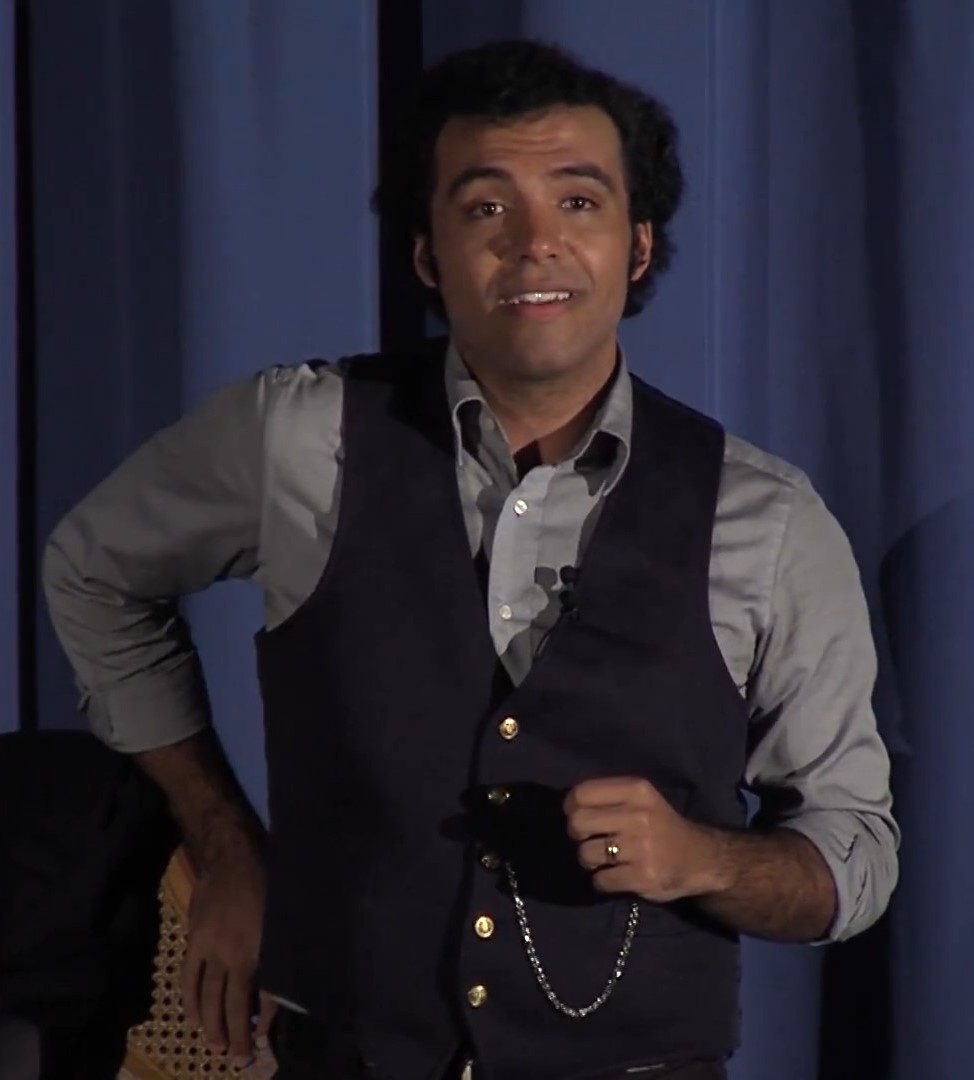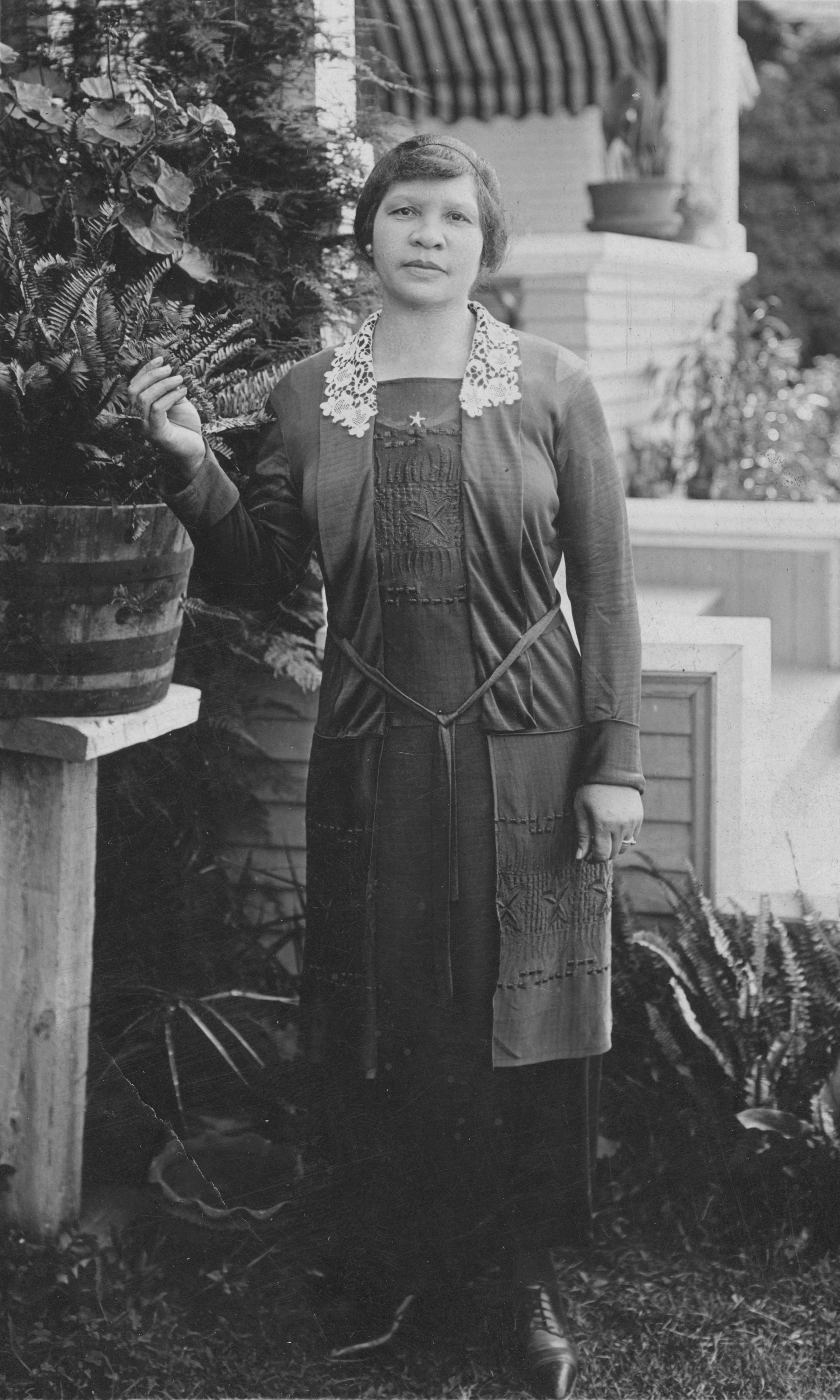Racial Justice: African-Americans in Early California - Biddy Mason Park
Biddy Mason
 Biddy Mason, African-American nurse and entrepreneur, was born a slave on August 15th, 1818 in either Georgia or Mississippi. Having never known her birth mother, Mason worked for a series of masters across Mississippi throughout her youth and early adult years. In the early 1840s, Mason and her three children were purchased by Robert Smith, a moderately-successful planter and follower of the Latter-Day Saint movement. After the 1844 death of Latter-Day Saints' founder Joseph Smith (no relation to Robert Smith), a succession crisis inspired the mass migration of Mormons out of the Midwest to the Utah Territory’s Salt Lake Valley in April 1847. In keeping with the exodus, Robert Smith and his wife Rebecca took Biddy and her children on an overland journey out of Mississippi to Utah. The route is estimated to have been around 1,600 miles and lasted well into 1848. After spending three years in a pro-slavery Utah settlement, The Smiths took the Mason family to San Bernardino, California in 1851.
Biddy Mason, African-American nurse and entrepreneur, was born a slave on August 15th, 1818 in either Georgia or Mississippi. Having never known her birth mother, Mason worked for a series of masters across Mississippi throughout her youth and early adult years. In the early 1840s, Mason and her three children were purchased by Robert Smith, a moderately-successful planter and follower of the Latter-Day Saint movement. After the 1844 death of Latter-Day Saints' founder Joseph Smith (no relation to Robert Smith), a succession crisis inspired the mass migration of Mormons out of the Midwest to the Utah Territory’s Salt Lake Valley in April 1847. In keeping with the exodus, Robert Smith and his wife Rebecca took Biddy and her children on an overland journey out of Mississippi to Utah. The route is estimated to have been around 1,600 miles and lasted well into 1848. After spending three years in a pro-slavery Utah settlement, The Smiths took the Mason family to San Bernardino, California in 1851.
With California being admitted into the Union as a free state in 1850, the Smiths’ continued ownership of Mason and her children was illegal. For a brief time, Robert Smith was possibly one of the wealthiest settlers in all of San Bernardino, but after an ill-fated real estate deal, Smith was excommunicated from the Mormon Church and had his farmland taken without compensation, prompting him to sell off his cattle and prepare with Rebecca to move to Texas. California’s Fugitive Slave Act of 1852 announced that slave owners could take their slaves back to their home state only. Since Smith was planning on taking Mason and her children to Texas, not Mississippi, his actions were against the law. Upon hearing the news from Mason, her free Black friends alerted the local sheriff, prompting the authorities to hold her and her children in protective custody. A case was formally opened, presided over by Maryland-born Judge Benjamin Hayes. In order to get around the laws forbidding African-Americans from testifying against Whites, Hayes had Mason interviewed in his personal chambers. Upon hearing that Mason did not want to go to Texas, Hayes confirmed that the Smiths assertion declaring otherwise to be false. In the case of Mason v. Smith in 1856, Hayes declared that fourteen African-American slaves, including Mason and her children, to be “entitled to their freedom and are free forever.”
Living free in California at the age of 37, Mason spent the next 35 years working in medicine and entrepreneurship. On the advice of a physician who had mentored her while working as a nurse, Mason bought a one-acre plot of land between Fort Street (now Broadway) and Spring Street (between 3rd and 4th Streets), making it a home for herself and her family. With her increasing funds, Mason opened a daycare center for working parents and a grocery account for families who suffered from natural disasters to buy essential goods. In the early 1870s, Mason co-founded the First African Methodist Episcopal Church of Los Angeles, the oldest Christian church of its kind in Los Angeles. By the end of her life, Biddy Mason had amassed a fortune equivalent to $7.5 million, making her one of the wealthiest women in the history of Los Angeles. She died of old age on January 15th, 1891, survived in-part by her children and great-grandchildren. Today, her legacy is commemorated by the Biddy Mason Memorial Park in Los Angeles, which was built upon the same land as her old homestead. Another patch of land she bought in 1866 is now called Biddy Mason Park, and the entrepreneurial aspects of her life are upheld by the Biddy Mason Foundation, led in-part by Cheryl and Robynn Cox, both sixth-generation descendants of her.
Pictured: Portrait of Biddy Mason, from Wikimedia Commons, https://commons.wikimedia.org/wiki/File:Biddy_Mason_(00026783).jpg.
Peter Biggs
 Peter Biggs, African-American barber and entrepreneur, was born around 1820. For about the first 20 years of his life, Biggs toiled as a chattel slave in Virginia. During an era some historians call the “Second Middle Passage,” African-American slaves were sold from the “Upper South” of Virginia to the “Deep South” of Alabama, Mississippi, and Louisiana. A smaller branch of this forced movement moved to the Western frontier, among which Biggs found himself being taken. After a decade of work under different masters in Missouri and Alta California, Biggs was freed just in time for the California Gold Rush, prompting him to move to Los Angeles in 1848 for better opportunities. Shortly after his arrival in California, Biggs fell in love with and married Refugio Rodondo, a young Spanish woman, and had a child with her.
Peter Biggs, African-American barber and entrepreneur, was born around 1820. For about the first 20 years of his life, Biggs toiled as a chattel slave in Virginia. During an era some historians call the “Second Middle Passage,” African-American slaves were sold from the “Upper South” of Virginia to the “Deep South” of Alabama, Mississippi, and Louisiana. A smaller branch of this forced movement moved to the Western frontier, among which Biggs found himself being taken. After a decade of work under different masters in Missouri and Alta California, Biggs was freed just in time for the California Gold Rush, prompting him to move to Los Angeles in 1848 for better opportunities. Shortly after his arrival in California, Biggs fell in love with and married Refugio Rodondo, a young Spanish woman, and had a child with her.
In the 1850s, Los Angeles was a hotbed of racial tensions and violence. Knowing the risks, Biggs still felt that there were ample business opportunities in California, and his experiences as a slave and a free man would be put to use in the field of entrepreneurship. After a brief stint as a manager and shipper of rat-hunting cats to San Francisco, Biggs opened his most well-known enterprise in 1850-51; a barbershop. Biggs, having experience in both Virginia and Missouri as a barber, specifically advertised his Los Angeles barbershop to white Southern men, a strategy that would not only ensure profitability from the majority white population, but would also further advance Biggs’ ascent of the social ladder in Los Angeles. As other Black entrepreneurs began to emerge, including Biddy Mason and Robert Owens, Biggs found his presence as Los Angeles’ premiere Black businessman challenged, but he opted to maintain friendly relationships with them. Throughout the Civil War, Biggs further emphasized the Southern aspects of his barbershop’s appeal, going so far as to recite pro-Confederate talking points, and even advertising himself in newspapers as “the Black Democrat.”
With the Civil War ending in Union victory in 1865, and the 13th Amendment outlawing slavery later that year, the relatively steady race relations in Los Angeles exploded into a massive surge of racial violence. Many whites, including Biggs’ customers, perceived that the liberation of African-Americans from slavery would be a gateway to having to recognize Chinese immigrants, Indigenous peoples, Latinos, and other ethnic minorities as American citizens. Though Biggs remained largely successful for four more years after the war’s end, he found himself arguing with a young Mexican waiter named Victor Lamorie on May 5th, 1869, to which Biggs was stabbed to death. The majority Spanish-surnamed jury declared Lamorie not guilty, the reasons as to why still being debated by historians today. The children of Biggs and his wife all died before they could have their own children, leaving behind no modern connections to Biggs, which also contributed to the obscurity of his legacy compared to that of Biddy Mason and Robert Owens, both of which still have living family descendants. The first written histories of Los Angeles barely mentioned Biggs beyond such descriptions as the “first Black barber,” or “first barber.” In popular media, it is possible that Biggs was the inspiration for a character in the 1930 Western film “The Lash.” While the film is considered lost, the book adaptation still exists, and serves as the last fragment of his memory in popular culture. In 2018, Biggs was portrayed by Jarred Webb as part of UC Santa Barbara’s lecture series“Innovator Stories: Creating Something from Nothing.”
Pictured: Jared Webb in-role as Peter Biggs, from University of California Television, https://www.youtube.com/watch?v=fpbqJwJKUDc
Charlotta Bass
 Charlotta Bass, the first African-American woman to operate a newspaper company and be nominated for Vice President, was born in South Carolina on February 14th, 1874. Born the sixth of eleven children to Hiram and Kate Spears, Charlotta moved to Rhode Island to work with one of her brothers in 1894. She worked as a seller of advertisements for the Providence Watchman, a Black-oriented newspaper in the eponymous city. At the age of 30, Charlotta moved to California in 1904 to work in a climate more accommodating of her medical needs. Two years later, she was hired by John J. Neimore to work for The California Owl, the first African-American newspaper in Los Angeles. Throughout Neimore’s career, The California Owl had become a household name among the Black community in Los Angeles, as it provided commentaries and information on housing, jobs, politics, social developments, and other such topics specifically catered for them.
Charlotta Bass, the first African-American woman to operate a newspaper company and be nominated for Vice President, was born in South Carolina on February 14th, 1874. Born the sixth of eleven children to Hiram and Kate Spears, Charlotta moved to Rhode Island to work with one of her brothers in 1894. She worked as a seller of advertisements for the Providence Watchman, a Black-oriented newspaper in the eponymous city. At the age of 30, Charlotta moved to California in 1904 to work in a climate more accommodating of her medical needs. Two years later, she was hired by John J. Neimore to work for The California Owl, the first African-American newspaper in Los Angeles. Throughout Neimore’s career, The California Owl had become a household name among the Black community in Los Angeles, as it provided commentaries and information on housing, jobs, politics, social developments, and other such topics specifically catered for them.
After Neimore’s death in 1912, control of the newspaper was given to Charlotta, who married co-worker Joe Bass two years later. Now known as Charlotta Bass, she changed the newspaper’s name to The California Eagle and expanded it from a four-page tabloid to a twenty-page weekly paper. Bass then shifted the paper from giving general information to the Black community in Los Angeles to a more politically-engaged angle, as she sought to fight against what she called the “two-headed monster, Segregation and Discrimination.” Highlighting political and social injustices taking place against African-Americans in Los Angeles and the rest of the country, Bass asserted that such injustices were anathema to the tenets of unalienable rights in the Constitution. From 1914 to 1951, The California Eagle continued publishing activist writings and articles, the topic ranging from discrimination in the military and government, police brutality, discriminatory zoning laws in Los Angeles, the Scottsboro Case of 1932, and several other campaigns and causes.
Eventually in 1951, Bass sold the company to former employee and attorney-at-law Loren Miller. Interested in supporting the Progressive Party, Bass briefly moved to New York City. Having grown frustrated of both the Democratic and Republican Parties positions on race and women’s issues, Bass registered herself as Independent, to which she co-founded the Independent Progressive Party of California. In her most ambitious and well-known political act, Bass ran for Vice President on the Progressive Party ticket in the 1952 Presidential Election. Though unsuccessful, it is likely that she knew she would not win, as she asserted during her campaign that whether she won or lost, “we win by raising the issues.” Her more controversial acts included being a member of the anti-nuclear weapons group Peace Committee of the World Congress, as well as visiting the Soviet Union and praising their country for achieving what she considered “racial equality.” The FBI soon started monitoring and logging her activities, and the Postal Service went as far as to try to confiscate her passport. Amid threats from home, Bass continued to advocate for her causes. The California Eagle was eventually shut down in 1964 due to poor management after Loren Miller’s departure, while Bass herself died on April 12th, 1969 at the age of 95. Before her death, Bass proudly remarked in her autobiography about the “triumphant emergence of the Negro as a top contender for honors in all fields.” The original site of The California Eagle was cited by the National Park Service’s Historic Resources Associated with African-Americans in Los Angeles. On March 17th, 2009, the site was formally placed on the National Register of Historic Places.
Pictured: Portrait of Charlotta Bass, from USC Digital Libraries, https://digitallibrary.usc.edu/CS.aspx?VP3=CMS3&VF=Home.
Lesson Plans
To better understand the biographies we have provided, and to contextualize the field trips to the historical sites, a series of lesson plans have been provided for the use of students and faculty. They may be read online, downloaded, and printed as needed.
Understanding the Past
Click here to download "Biddy Mason Gets Her Freedom" lesson plan.
Applying to the Present
Click here to download "Slavery in the 21st Century" lesson plan.